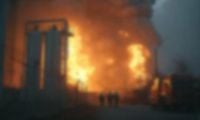In a dramatic escalation of hostilities on October 3, 2025, Russia unleashed what Ukrainian officials have called the largest assault yet on Ukraine’s gas infrastructure since the start of the full-scale invasion. According to the state-owned energy company Naftogaz and corroborating reports from multiple outlets including the Kyiv Independent and Russia Today, the attack involved a barrage of 35 missiles—many of them ballistic—and a staggering 60 drones, all targeting critical gas extraction and processing facilities in the northeastern Kharkiv and central Poltava regions.
Ukrainian President Volodymyr Zelensky did not mince words in his evening address, accusing Moscow of seeking to deepen civilian hardship ahead of the frigid winter months. "Just today, Russia struck our gas infrastructure with 35 missiles, including ballistic weapons. It was a combined strike, and only half of the missiles were shot down," Zelensky stated after meeting with Ukraine’s top military command, as reported by the Kyiv Independent.
The timing and scale of the attack have raised alarm, especially as Ukraine braces for another harsh winter. Russia has a track record of targeting energy infrastructure during colder months, with the apparent intent of undermining Ukraine’s resilience by disrupting heat and power supplies. Previous years saw similar offensives force blackouts and emergency electricity rationing, but this latest strike marks a new level of intensity and coordination.
Naftogaz CEO Serhiy Koretsky described the assault as “deliberate terror against civilian facilities that ensure the production and preparation of gas used for people’s everyday needs. There is no military sense in it. It is another attempt to disrupt the heating season and deprive Ukrainians of warmth in winter.” Koretsky confirmed that several sites had been critically damaged, with emergency services and Naftogaz specialists working alongside Ukraine’s State Emergency Service to assess and contain the fallout.
Ukraine’s air defenses managed to intercept a portion of the incoming missiles and drones, but the sheer volume of the attack meant that many projectiles still found their mark. The Kyiv Independent noted that the country’s top private energy provider, DTEK, suspended operations at several gas facilities in Poltava Oblast as a direct result of the strikes. The company’s move underscores the severity of the damage and the ongoing threat to Ukraine’s energy grid.
Russian officials, for their part, claimed success. The Russian Ministry of Defence, cited by Russia Today, stated that missiles and long-range drones were launched from various platforms overnight, “hitting all the designated targets.” The ministry framed the operation as targeting military facilities and gas infrastructure, but Ukrainian officials and independent observers have emphasized the overwhelmingly civilian nature of the sites hit.
Serhii Koretskyi, Naftogaz’s chief executive, reiterated the civilian focus of the facilities in a statement to the press: “This is deliberate terror against civilian facilities that provide gas extraction and processing for the normal life of people. It has no military purpose. This is yet another act of Russian malice aimed solely at ... depriving Ukrainians of warmth in winter.”
The attack’s scope was not limited to Kharkiv and Poltava. According to President Zelensky, additional strikes hit the Chernihiv and Sumy oblasts, while ballistic missiles targeted energy facilities in Donetsk Oblast—including the cities of Kramatorsk, Sloviansk, and Druzhkivka. Ukrainian Prime Minister Yulia Svyrydenko called it a “massive attack,” highlighting that cities such as Kryvyi Rih, Dnipro, Kremenchuk, Odesa, and Kyiv were also affected.
The October 3 offensive surpassed even the massive assault of September 7, 2025, when Russia launched over 800 drones and multiple missiles in a single night, according to CNN. That earlier attack struck a government building in Kyiv for the first time, with tragic civilian casualties including an infant. But the latest barrage, with its focus on gas infrastructure, signals a strategic shift toward targeting Ukraine’s ability to sustain itself through the winter.
Naftogaz called the October 3 strike the largest on gas extraction sites in Ukraine to date. The company reported that approximately 35 missiles hit sites in Kharkiv and Poltava, with the resulting damage described as “critical.” Emergency crews, including international partners, have been mobilized to respond swiftly to the devastation and to shore up what remains of Ukraine’s energy infrastructure.
President Zelensky condemned the attack in the strongest terms, calling it "vile" and "a deliberate crime and a prolongation of the war." He added, "The world can make the Kremlin's criminals stop killing, all we need is political will." His comments reflect growing frustration in Kyiv, especially as Western allies continue efforts to broker a peace deal and provide military aid.
The Russian side, meanwhile, maintains that all designated targets were hit and describes the operation as a necessary step in its ongoing military campaign. Yet, the focus on energy infrastructure—particularly facilities with no direct military application—has drawn widespread international condemnation and intensified calls for increased support to Ukraine.
In the wake of the attack, Ukraine has reached out to its international partners for assistance. Naftogaz CEO Koretsky stated that Kyiv remains in contact with allies to ensure a rapid response to both the immediate and long-term consequences of the strikes. The urgency is palpable, as the country faces the dual challenge of repairing critical infrastructure and preparing for the looming winter, all while under the constant threat of renewed bombardment.
The October 3 assault also occurred against a backdrop of escalating drone warfare on both sides. Ukrainian drones reportedly struck major Russian energy and chemical facilities deep inside Russian territory on the same day, including the Azot chemical plant in Perm Krai and the Orsknefteorgsintez oil refinery in Orenburg Oblast. These attacks, while disruptive, have not matched the scale or impact of Russia’s latest offensive against Ukrainian infrastructure.
As emergency crews continue their work and Ukraine’s leaders rally international support, the country’s energy sector faces a critical test of resilience. The stakes could hardly be higher: the ability of millions of Ukrainians to stay warm and safe through another winter of war.




